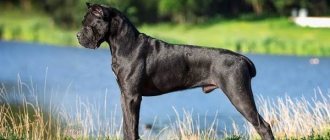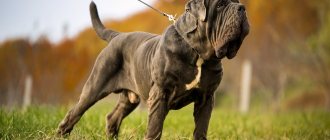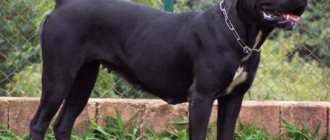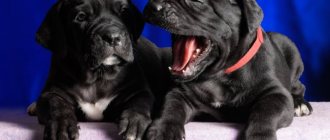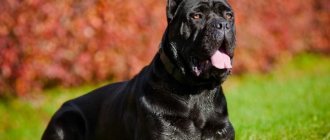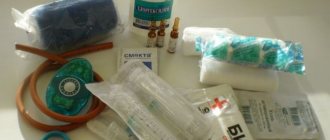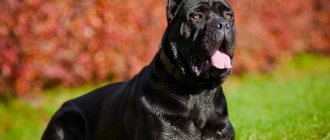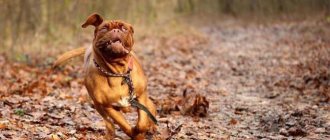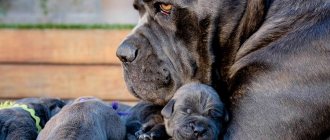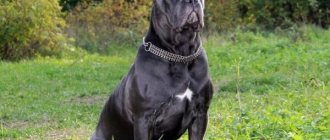Today, the Cane Corso standard is dictated by a document from the FCI, the Federation Cynologique Internationale, which came into force on January 1, 2016. It is not that much different from the previous one, but when searching for information, do not forget that you may stumble upon outdated information.
In this article we will talk in detail about the standard of this dog breed that is in force today, we will try to highlight important nuances and answer questions that often worry Cane Corso Italiano owners. All this will come in handy even if you do not intend to raise your puppy into a champion dog.
History of the breed
To find the beginning of the history of the Cane Corso breed, you need to “look” into the distant past. Representatives of the oldest group of Molossians are the direct ancestors of modern Corso. Their ancient Roman ancestors took part in competitions as gladiator dogs. Not only their powerful jaws and muscles, but also fearlessness helped corsas fight against opponents superior in size and strength, and win battles.
When the Roman Empire collapsed, these fighting dogs lost their popularity. At the beginning of the Middle Ages, the history of the Italian breed again gained momentum. Cane Corsos spread throughout Europe. Their images are preserved on canvases and engravings of that period. Artists could not ignore this fearless dog, which was used to hunt wild animals. The powerful dogs did not retreat before either the bear or the wild boar. The Italians of that time, and contemporaries too, say: “Brave, like Corso.”
Over time, the hunting skills of the Roman Molossians faded into the background and became unclaimed. Now the duties of the Cane Corso included the protection of livestock and farms. Dogs were used to transport large herds. In a word, dogs of this breed could be found in rural areas; they were very rare on city streets.
This lasted until the start of the war with the Nazis. Over the years of battles with the German invaders, the Cane Corso population decreased significantly. At the end of the war, the breed was on the verge of extinction. During this time, Italian dogs were rarely seen even on farmland. Experienced breeders managed to restore the breed and increase the number of its representatives, who noticed in time that the Cane Corso was facing extinction. The revival of the Roman Molossians began with a few surviving individuals of purebred blood. Now representatives of the Italian breed can be found both in the city and in the countryside. These dogs are no longer in danger of extinction; their popularity is growing.
How to choose?
Before choosing a Cane Corso puppy, you need to choose a kennel. It is important that the nursery maintains the purity of the breed and its quality.
It is necessary to pay attention to:
- cost of a puppy – quality Blue Corso puppies cost from $250 to $1,500;
- nursery conditions;
- availability of documents for puppies;
- presence of pedigree;
- the behavior of the breeder himself.
The puppy must be strong, well-fed, active and courageous . It is best to ask the breeder to show the puppy's father and mother, then the breed standard can be assessed.
IMPORTANT!
The puppy must have a puppy certificate and an international veterinary passport, which contains information about vaccinations and helminth prevention.
Such a document is issued 45 days after the birth of the puppies.
There must be a mark on the dog’s belly that corresponds to what is indicated in the metric.
Breed standard
The Cane Corso is a large breed with well-developed muscles. The weight of adults is 40-50 kg. , height at withers 60-68 cm . Males are noticeably larger than females. A characteristic feature of the breed is that the length of the slightly sloping body exceeds the height at the withers. A wide, large head with a protruding forehead rests on a powerful neck. The ears are triangular in shape and drooping.
In many cases, the ears are cropped. The width of the muzzle exceeds the length. Powerful jaws, easy to bite. Black nose with large nostrils. The eyes are slightly bulging and dark. According to the standard, an eye color that matches the color is allowed. The shape is oval, the gaze is attentive, studying.
The chest is well developed and the body is powerful. The forelimbs have well-developed muscles, are long, and the shoulders are powerful. Hind legs with dry shin and long thigh. The skin is thick.
The tail is thick and set high. Stopped after the fourth vertebra. If the dog is alert and excited, then he lifts him up. According to the standard, it is unacceptable for the tail to curl or be in a vertical position.
The coat is short with little undercoat. The coat color can be red and gray with different shades, brindle, black. There is a gray or black mask on the face, with the exception of Cane Corso with gray or black coat color. According to the standard, white markings are allowed on the paws and chest.
Cupping
Whether the ears and tail need to be cropped is up to each owner to decide for himself. This is an optional requirement. However, docking the ears and tail gives the dog a well-groomed appearance. Thanks to the efforts of animal rights activists, docking the ears and tails of dogs is prohibited in many countries. Therefore, only animals with undocked ears and tails perform at exhibitions.
ears
Previously, ear cropping in the shape of an equilateral triangle was allowed. For these purposes, a special pattern is used. This operation is allowed in Russia. However, to perform it you need to know how to place your ears. Also, such ears require special care at first, otherwise the injured ear will not heal for a long time.
Tail
Many people also used to shorten the Cane Corso's tail. It usually stops at the level of the fourth vertebra. This was done in order to avoid tail fractures in hunting dogs.
Just like a cropped ear, a docked tail requires extra care. It is especially important in the first days after the operation, otherwise the wound may begin to fester.
As you can see, it is no longer necessary to crop the Cane Corso’s ears and tail today. Although in some countries such animals are still found and are even allowed to participate in exhibitions.
Maintenance and care
Keeping and caring for Corsos is not difficult at all. But if you do not follow the usual rules, the dog will not feel comfortable, will not be able to fully develop and will get sick.
Let's start with the fact that the Cane Corso breed comes from Italy; it is not suitable for keeping in the yard during our severe winter frosts. If you do keep such a dog in an enclosure, provide it with a warm kennel. Puppies should not be kept indoors without heating at all. You should also remember that corsas need communication; when kept in an enclosure, they need to be allowed out for walks, to play, and to communicate with them often.
Gone are the days when Corsas guarded the property of Italian farmers and were kept only on the street. Nowadays, these dogs get along well in apartments. When properly raised, they behave calmly and do not cause problems. But if you deprive them of the opportunity to throw out the accumulated energy, they will begin to play pranks, testing their teeth on pieces of furniture, interior design, shoes, etc.
If such a dog gets bored, if left alone for a long time, he is capable of chewing even the front door. That is why daily long walks are so important, during which the dog should have the opportunity to run, jump, play with the owner and with other dogs.
Having settled a puppy in the house, be prepared that at first he will whine at night, missing his mother. If you warm him up on your bed at least once, it will be very difficult to evict him from your apartment. The pet quickly appropriates its territory and begins to consider the owner’s bedroom as its own. Therefore, it is so important from the first day to determine for the puppy a place with a bed on which he will sleep and rest. This place should not be in the backyard of the house, not in a draft, not near heating appliances. Also immediately place bowls for food and water in a certain place.
It is important to carry out all hygiene procedures on time and correctly:
- Brush the coat once a week with a stiff brush, and during shedding period 2-3 times a week.
- If necessary, treat for fleas and ticks. Due to the lack of undercoat, parasites can cause a dog a lot of suffering and even lead to diseases.
- Bath 1-2 times a year or when heavily soiled. Considering that the Cane Corso loves natural bodies of water, during the warm season, give your pet the opportunity to splash in a lake or river.
- Regularly inspect and clean your ears; if they are cropped, they get dirty faster than hanging ones. The owner must take this fact into account. During the procedure, use pieces of soft cloth or gauze soaked in a special liquid purchased at a veterinary pharmacy.
- Wipe eyes with cotton swabs. Make sure there is no excessive discharge. If you notice inflammation or excessive discharge, contact your veterinarian.
- Trim the claws as they grow.
Cane Corso price
The price for an Italian Cane Corso in kennels starts from $1000. The most expensive puppies are of rare color and promising (from parents who have received recognition at international exhibitions). You can buy a dog for a lower price, but in this case it will most likely be without documents and with any defects.
Although for people who do not intend to exhibit their pet, but simply want to have a loyal friend and a good guard, the wrong color or whitish eyes are unlikely to become a serious problem.
Nutrition
For a large guard dog, a high protein content in the diet is vital. A puppy cannot turn into a big, active dog on one porridge. Without meat products, the Cane Corso will not be able to fully develop. But not everything from this category can be fed.
For example, fatty meats such as pork are not advisable. Beef is preferable. If you give raw meat, it must first be frozen to prevent infection with internal parasites. You cannot feed your dog smoked meat, tubular, small bones. If you give bones, they should be large, then they will be useful. Tripe and offal are also beneficial for your pet's body. In total, protein products should account for about 70% of the total diet.
In addition to meat, the Cane Corso menu must include vegetables, fruits, cereals, and low-fat dairy products. Sweets, river fish, foods with spices, and legumes are prohibited. In general, all food that causes bloating is very dangerous for Corsos. Because bloating can be fatal in a very short time.
The following rules must be observed:
1. Feed adult dogs 2 times a day. 2. Change food gradually so that the animal’s stomach reacts normally to changes in food. 3. Food must be of high quality, be it natural products or dry food. 4. Feed at the same time. 5. Do not leave leftover food in the bowl. 6. Do not overfeed to avoid obesity. 7. Nutrition should be balanced. 8. Provide the required amount of vitamin and mineral supplements. 9. Clean, fresh, cool water should always be available to the pet.
Health
On average, Cane Corsos live up to 11 years. They are naturally strong, the health of these Roman Molossians is good, but a predisposition to certain diseases is still observed:
- Hip dysplasia is a pathology that is inherited.
- Elbow dysplasia is a disorder of the development of joint structures.
Read about hip and elbow dysplasia in our article: Joint dysplasia in dogs: a weak point of large breeds
- Cardiovascular diseases.
- Entropion - characterized by abnormal position of the eyelids (upper, lower or both). This disease is also called entropion.
- Eversion of the eyelid is a pathology in which the conjunctival surface of the eyelid is turned outward. If left untreated, blindness may occur.
- Stomach bloating is a dangerous condition that can be fatal within just a few hours.
- Epilepsy develops after stress, but this is not the only cause of the disease. Purebred animals, including corsas, are particularly predisposed to the disease.
The health of a dog depends entirely on nutrition and maintenance, in other words, on the owner. The owner must carry out vaccinations and preventive examinations and x-rays on time. At the first signs of illness, immediately contact a veterinarian, excluding self-medication.
Character
It is important to remember that the Corso is a fighting dog, its ancestors were gladiators, and its guard instinct was developed from birth. Living in an apartment, the dog considers all rooms to be his territory, which needs to be protected. Therefore, he perceives strangers as invaders, but this is only at first. Seeing that the owner is communicating peacefully with visitors, the Corso will calm down, but will still watch the stranger with a wary gaze. The serious, one might say, menacing expression of the muzzle inspires strangers not only with respect, but also with fear. You won’t want to pet such a dog, unless you are one of his friends.
Increased aggression in Corsas was not noticed. They are calm and balanced, they never attack or bite without reason. These dogs are characterized by the division of everyone around them (animals, people) into strangers and their own. The Cane Corso often shows his own initiative; he is able to make his own decisions, especially when it comes to protecting the borders of his territory. Reacts quickly in moments of danger and can quickly prevent an attack by a stranger. He never retreats, even if there are several armed people in front of him. This is why Corsas make excellent police dogs.
Smart, noble, intelligent - this is all the Cane Corso breed. Its representatives are devoted to the owner and all household members. This pet treats children with special tenderness. He is really aware of his strength, so he can play with small children. During such fun, the dog will never offend or push the baby. The child next to the corso is under his protection.
Loneliness and separation from the owner of the Corsa are difficult to bear. Even in puppyhood, the animal becomes strongly attached to its owner. Therefore, it is not recommended to leave them alone for a long time, much less refuse them and pass them on to other people. The Cane Corso's loyalty and affection must be responded to with love and care. The pet should have favorite toys (balls, bones, squeakers), this will help him pass the hours of loneliness. Use every free moment to play or just talk with your dog. Over time, the feeling will come that the dog understands every word you say.
Dog body parameters
The documents clearly define the parameters for each part of the dog’s body and even its character. So that you have a general idea, we will first give them briefly, and then consider each point in more detail and talk about the possible shortcomings and vices of the Corso.
The ideal representative of the breed must fit all the given parameters and have:
- correct proportions of the body and head; - good teeth and bite; - flexible, friendly character; - healthy gait with wide strides; - suitable height and weight; — the desired color is one of those included in the standard.
For mating, knowledgeable dog breeders take only those representatives who meet all the requirements of the standard.
Let's consider all the points in detail, because everywhere there are nuances and reservations, and the approach to dogs at various competitions can be contradictory.
